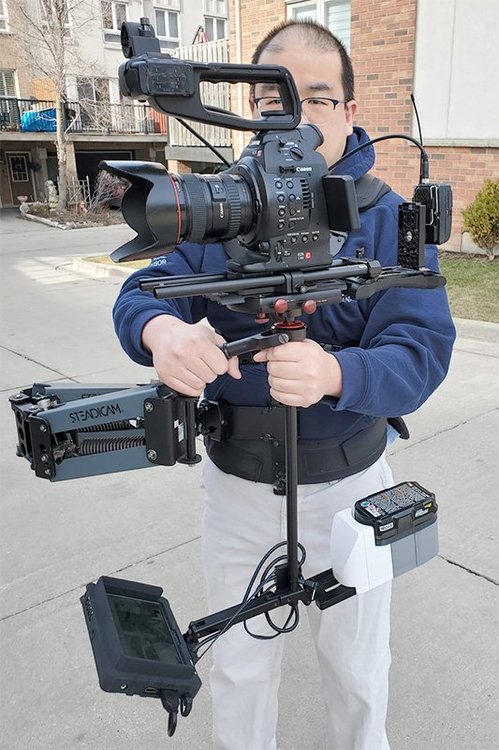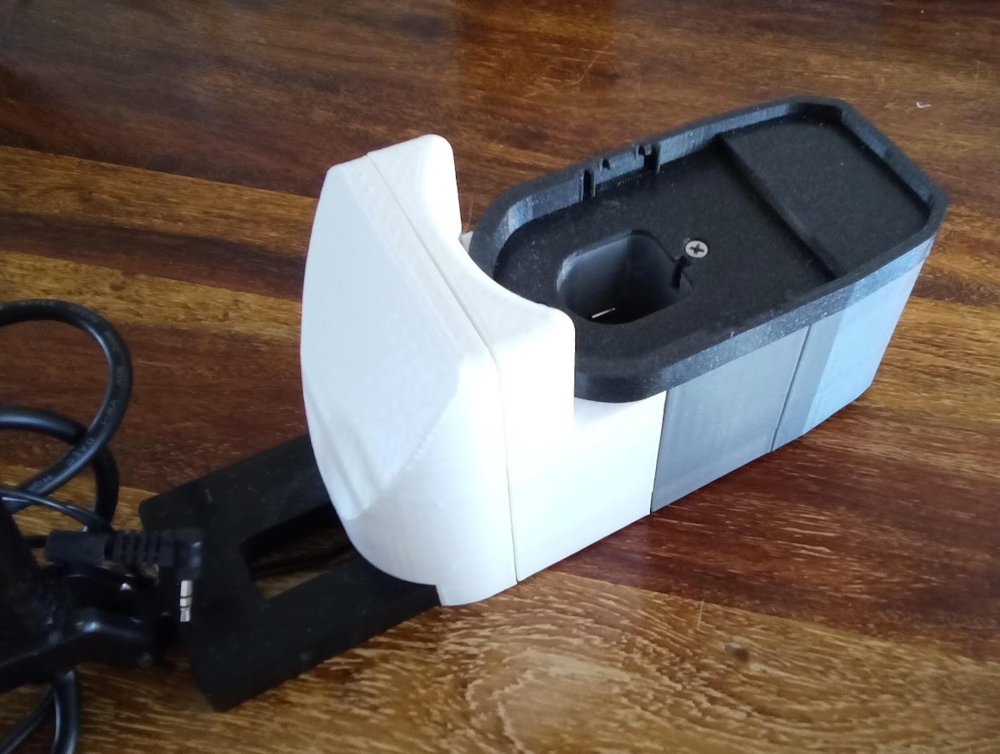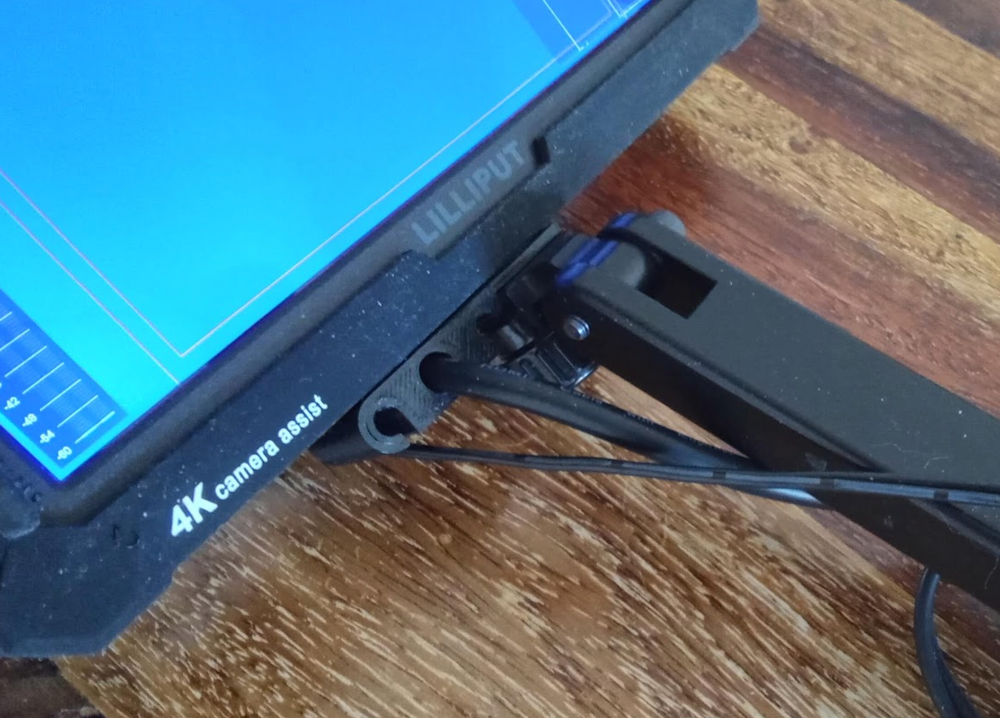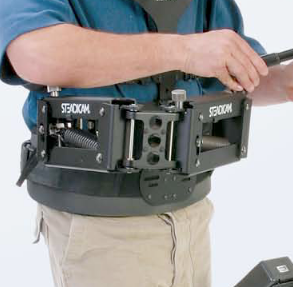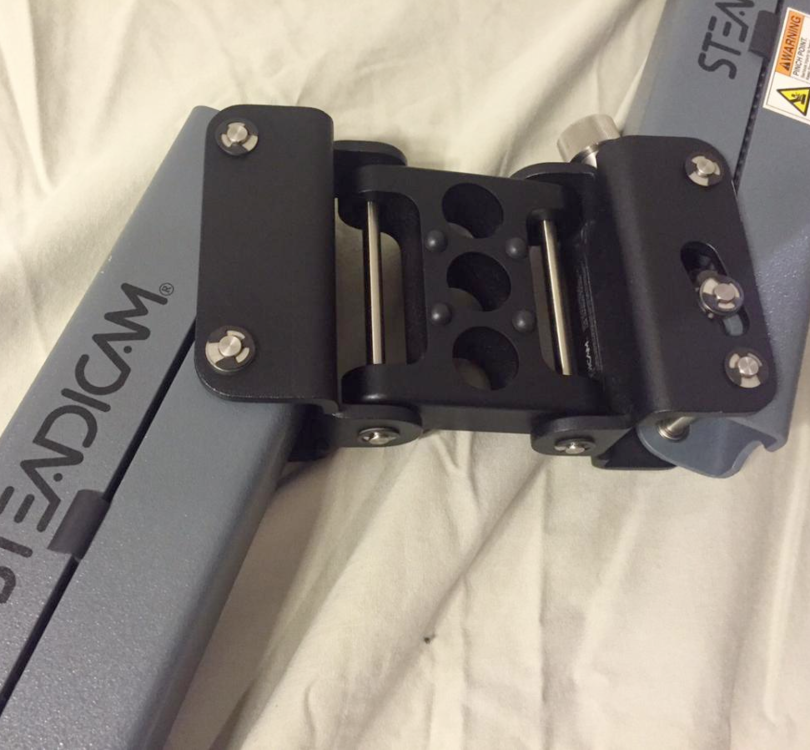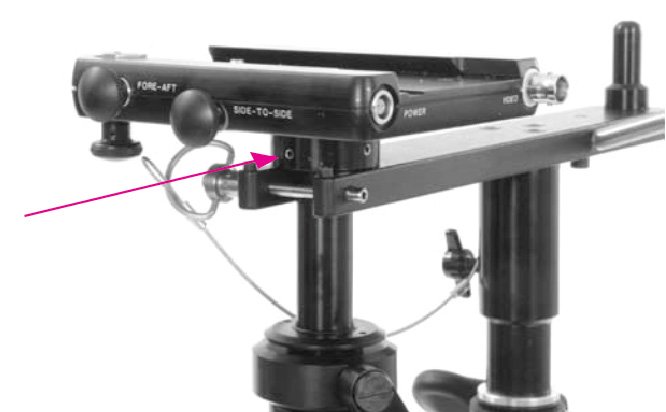
Calum Tsang
Members-
Posts
10 -
Joined
-
Last visited
Everything posted by Calum Tsang
-
I am probably the least experienced person here, as someone just fooling around with a Steadicam, but the tuning of the arm's neutral position (flopping toward and away from your body) seems pretty key. When I have this dialed in incorrectly, I find the sled runs away from me and I'm leaning out, or the sled is swinging back at me. That tuning is done using the socket block adjustments as mentioned above. This video explains those socket block adjustments: The arm on this Varizoom setup looks fairly rudimentary--and doesn't have the socket block or its linkage screws. I could see why--the Steadicam ones seem like they're machined from billet stock and quite heavy. It also doesn't appear to have any weight adjustment knobs on the arm which set in the up down (booming) trim. The whole thing looks a lot like the Steadicam Mini or SK models which have a simplified arm and vest attachment. I've found watching this site and places like Kijiji here in Canada that low end Pilots and Flyers aren't that expensive, which seem the minimum Steadicam setup. A couple hundred dollars more and I think it'd be a lot more capable.
-
In theory, SDI and HDSDI should work over the same old analog 75 ohm cable, which is what most composite analog video used: https://en.wikipedia.org/wiki/Serial_digital_interface#Electrical_interface The theory was decks/switching gear/cameras etc could change but the studio cabling wouldn't needed to be ripped out. But I'd be concerned about what might be inside, like a distribution amp or different cable type, given some of the Steadicam unique needs.
-
I'm also similarly interested in a different sled. The very narrow post on the original Flyer sled I have really constrains what I can send up and down, especially when using wireless video transmitters.
-
Thanks! This is the whole sled as it stands now. I have to figure out how to replace the gimbal collar with a new socket head cap screw, the previous owner mangled the current one such that it doesn't tighten easily. I have to order from an industrial supplier locally, the big box hardware stores don't carry small diameters. One thing I've love to figure out is how to put more camera functions onto the gimbal yoke, like record start/stop and One Shot focus. And some sort of zoom demand with a follow focus motor.
-
Thanks Bob! Here's some initial photos of the battery system. The battery was always going to be the most difficult component, as I didn't want to invest in batteries yet. I picked the Ryobi system because they have internal voltage protection, unlike DeWalt etc and also because I already had a 2Ah and 4Ah set from a lawn trimmer. (I know all serious operators choose hardware based on their lawn care equipment.) This is the rear battery holder which holds the Ryobi battery: I found a design on Thingiverse for the Ryobi mount (dark grey) and built a shape around it that captures the Flyer battery paddle (white and light grey). I had to print it several sections due to the limited build volume of my printer. I chose this shape to reduce snagging on cables and the like while moving. Once I get some experience with it, I will likely reprint it as one piece. I also designed a few cable clips to help route video and power around the rig. These have a 1/4" hole to thread under tripod mount and similar bolts: One of the next things I will order is some knockoff LEMOs from AliExpress. I spent two hours operating the rig this weekend, trying to dial in the arm tension, block and block threads. I got the sled balanced fairly well, but I could tell watching my footage my posture dying and the arm in/out/side to side changing. One thing I've realized is that my camera is at the very light end of the Flyer payload range, despite leaving just about every option attached (shotgun mount, top handle, handgrip), 15mm rails/shoulder pad. Over time that margin will help as I may need to add a lav receiver and a wireless video transmitter. I now also realized why the case included a random AB NiCad battery and a exercise weight--likely used to weigh down the rig for the previous owner who I think flew a 5D3 on it.
-
Well an update in case anyone is interested--I finally got my Flyer running! The pin is actually a curved piece of metal which forms a cylinder. It expands in the hole to pressure fit. To get it out, I ended up taking the end of a dollar store "jewellers" screwdriver, sawing off an inch of it, then carefully tapping it out with a hammer after spraying some WD40. After removing the pin, I managed to get a MicroHDMI connector through the narrow post, by shaving the connector plastic using a utility knife. I also ran some DC 24AWG through there for power, though I have not set up the camera on the LEMO. I soldered and trimmed the LM2596 DC to DC step down, and put it into a custom 3D printed fairing. So, after all these months, I have the world's only Ryobi drill battery powered Steadicam. Now to actually learn how to use it. I ran my first test today and realized the previous owner had set it up for goofy. But after that, I did manage to get the C100 to balance on its own!
-
Buy used Steadicam Flyer or new model?
Calum Tsang replied to Nolan Dennhardt's topic in Steadi-Newbies
I have no idea what I am doing, so take this with a grain of salt--the only thing I am qualified to talk about is the single old Flyer I bought earlier this year. For what it's worth, some of the first generation Flyers had a grey arm, though some of them are black. I can tell based on this middle hinge, which has three holes: Mine looks like this ad: This is a closeup of the hinge from that ad: Battery systems vary a lot. Mine came with a pair of NP1 slots...but Anton Bauer and IDX are common too. The Flyer vest I have has plastic buckles on the shoulders. There is no leather anywhere on the vest. This site has been invaluable for trying to understand what model is what: https://www.johnfrysteadicam.co.uk/the-steadicam-database/ I've been tracking Pilots/Flyers for a while in the GTA. Most seem to ask roughly $600-700 for a Pilot and about $800-1200 for a Flyer. I suspect you can probably negotiate a lower price, those are asking rates. -
Hi folks Does anyone know how to remove this pin? There's a small hollow pin that fixes a cylindrical "flange" to the shaft of the post. The flange piece has four holes tapped for screws to hold the top stage, the pin seems to fix the flange so the shaft won't drop away below. It seems pressure fit in there, but before I jam something through it, I thought I'd ask, just in case it was threaded or keyed some way.
-
Thanks! After some more digging, it does look exactly like a Mini sled. The good news is the whole system as far as I can tell is mechanically functional. The extent of the modifications is vast and requires significant unworking :) I disassembled and washed the vest. Turns out it's like washing a backpack or stuffed animal toy. Several of the wing screws (socket block, docking stand) were broken, so I found the replacement on McMaster Carr and got them. I cleaned up the arm. There seems to be nothing missing from the arm. The monitor is dim and mostly useless, so I have purchased a new 7" HDMI monitor. I am working on rewiring the center post, which on this generation of Flyer/Mini sled, is very narrow Piping HDSDI is a nonstarter for me, so I'm trying to get a Micro HDMI connector through the post. I will leave the BNC in case I ever need to use it. I will probably reuse the Lemo 0B connector on the sled, in case I ever need to fly another camera, such as a C300. I have designed and printed a fairing for a new battery to sit on the bottom, which will fit a (don't laugh) Ryobi drill battery and include a LM2596 DC stepdown converter to run both the monitor and C100. As I don't quite want to invest in a V lock/D tap battery system yet, this is by far the lowest cost/risk approach. I have to figure out focus assist/servo zoom I have to figure out how to clean the case it came in. It's a giant square velcro bag and was left in a garage so it seems dirtied by rodents etc. This is a big science project for me, so it's been really interesting.
-
Hi folks I recently bought a used Flyer and am modifying it for use with my C100, eg plumbing it for HDMI video and a new battery system. As I'm just experimenting with it, my goal is the lowest cost approach to making it work right now. One question I was hoping to learn more about was what exactly I have. I believe what I have is a very early Flyer original model: The arm is what appears to be an original Flyer "grey arm". It has a label which says it was manufactured by Tiffen and has the "modern" Steadicam logo. The sled on the other hand has a label which says Cinema Products (but with a Tiffen QA sticker) and has reddish adjustment knobs and a red gimbal grip. It has dual NP1 battery holders which appear to be original as the "paddle" has holes machined exactly for it. The lower sled is missing the Flyer branding on the monitor arm. The power cabling on the other hand is completely hacked around to power a third party LCD SD monitor, but the upper stage has a two pin Lemo 0B on it. The post is narrow, with a 15.8mm OD and the dovetail plate is about seven inches long. From what I've read here, the sled appears to be for a Steadicam Mini, which is functionally identical to the early Flyer sleds, except for colour. Is it possible that early Flyers shipped with surplus Mini sleds? As far as I can tell, there's no difference in appearance or operation from the manual. Thanks!

